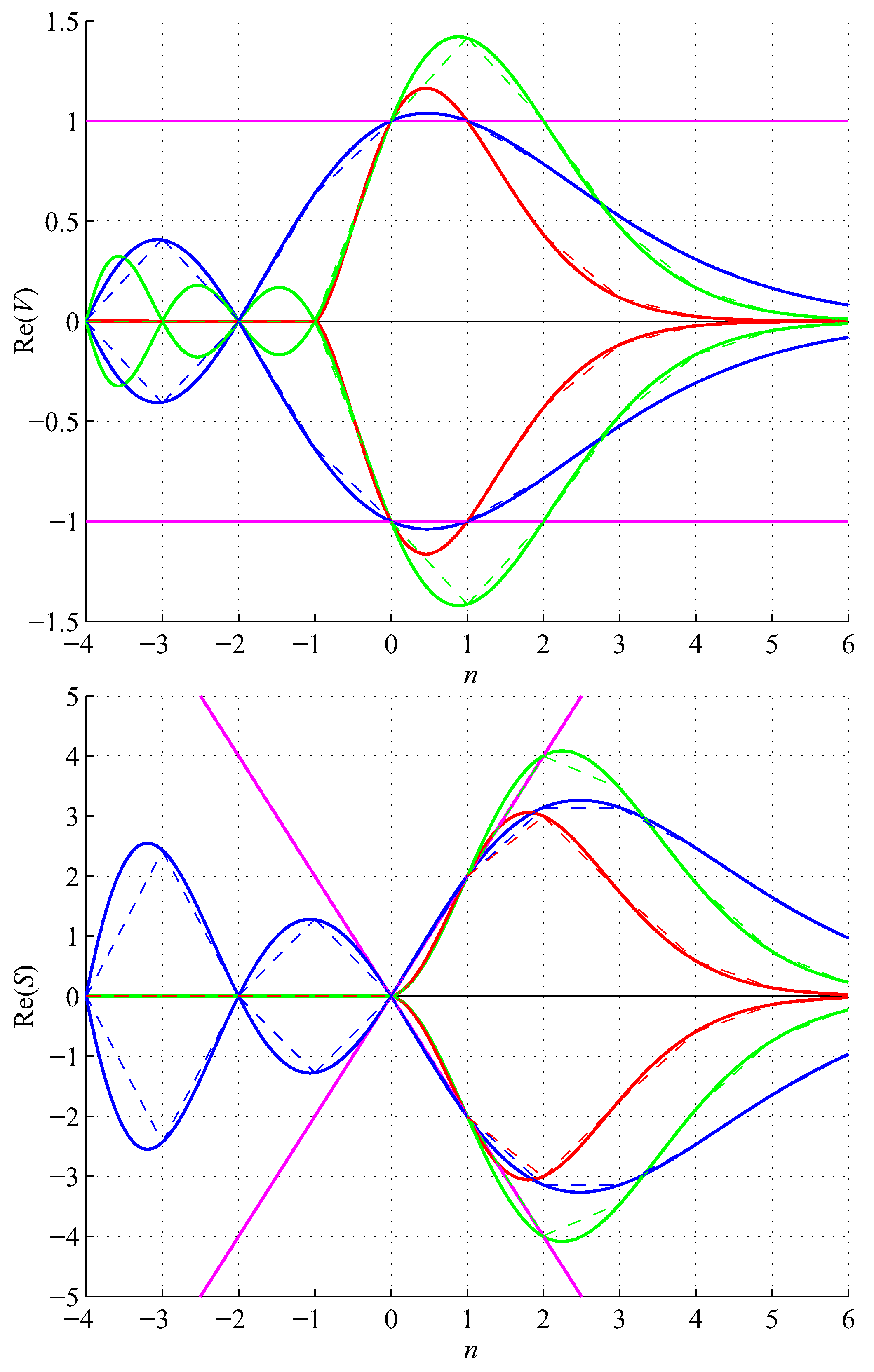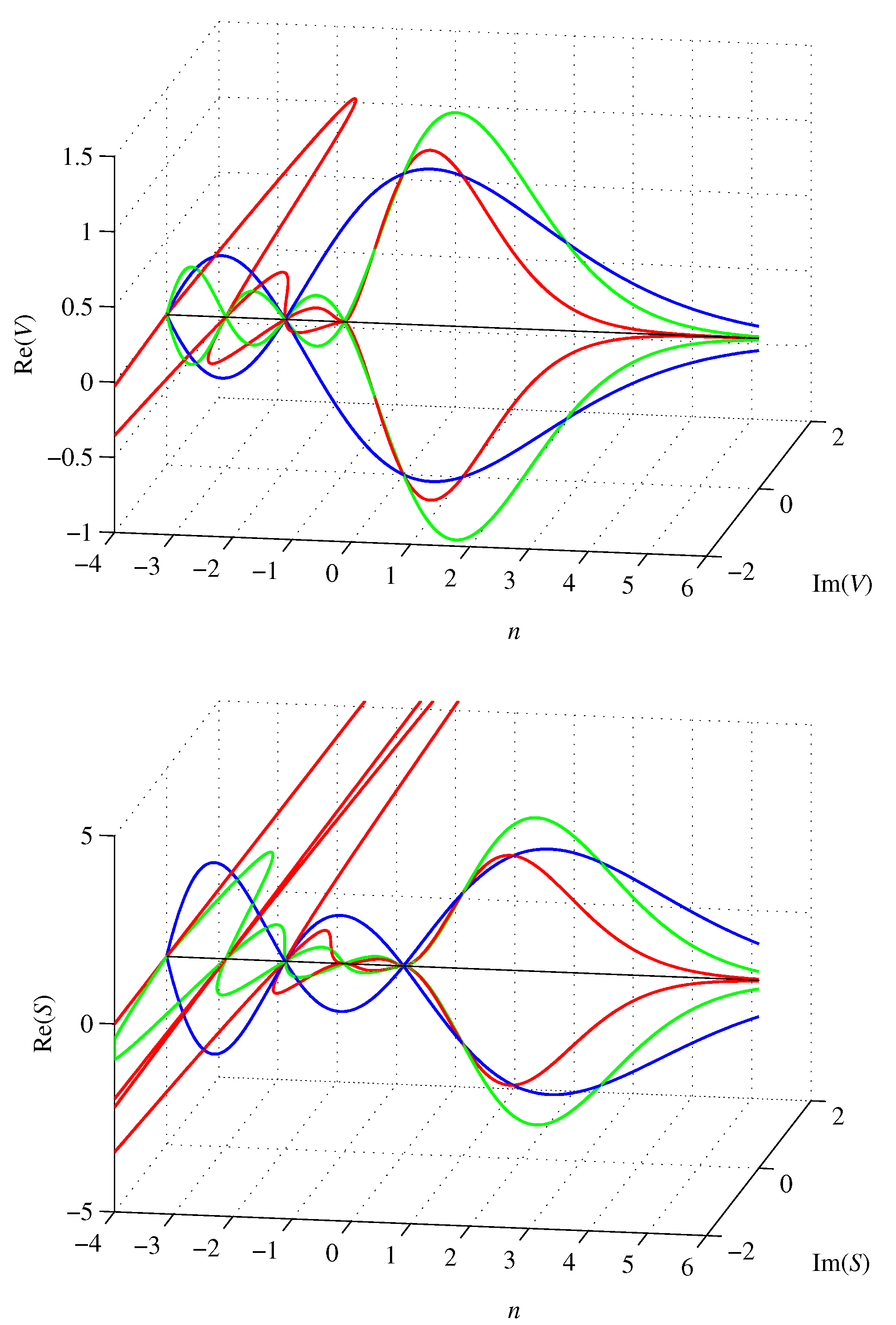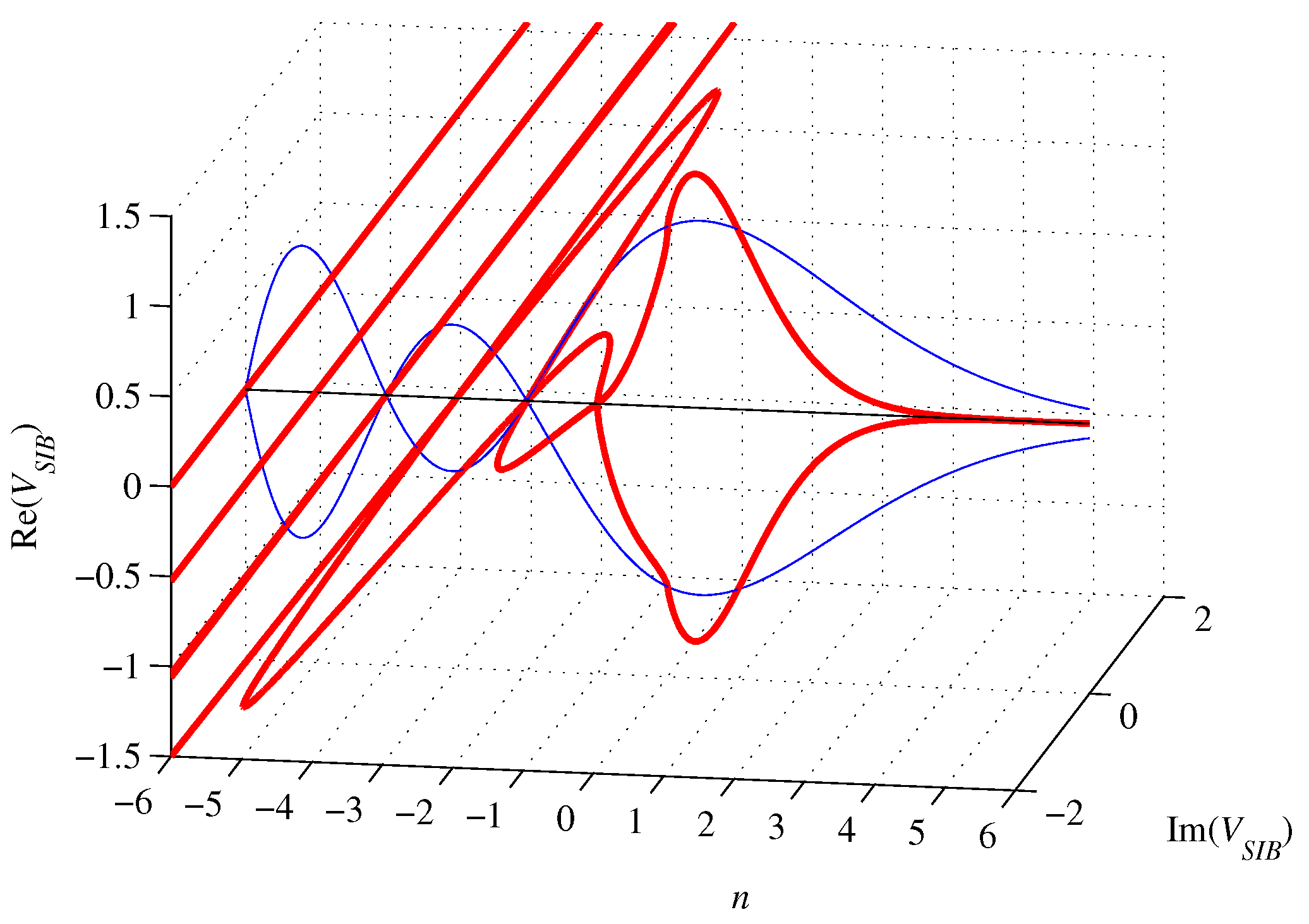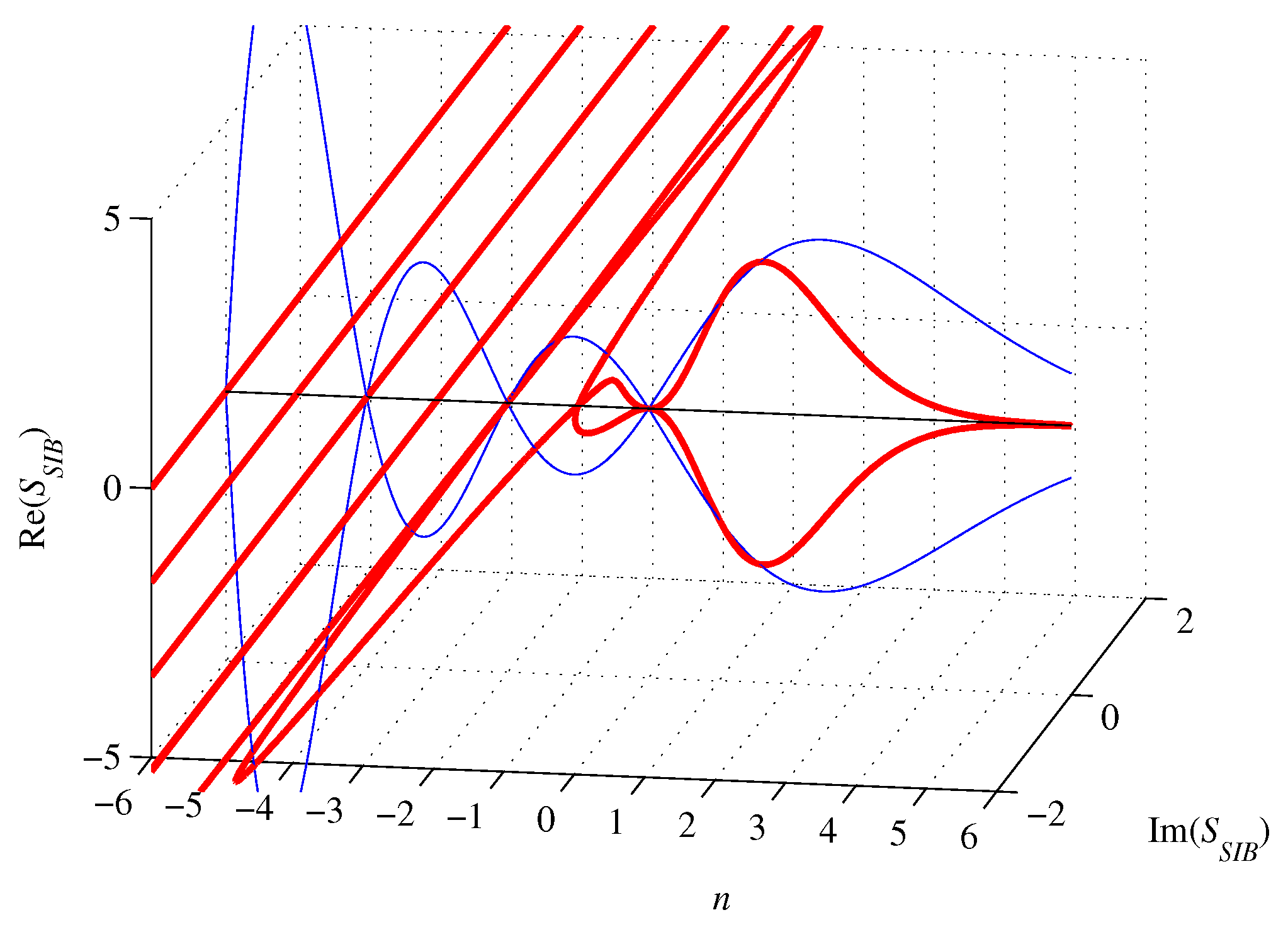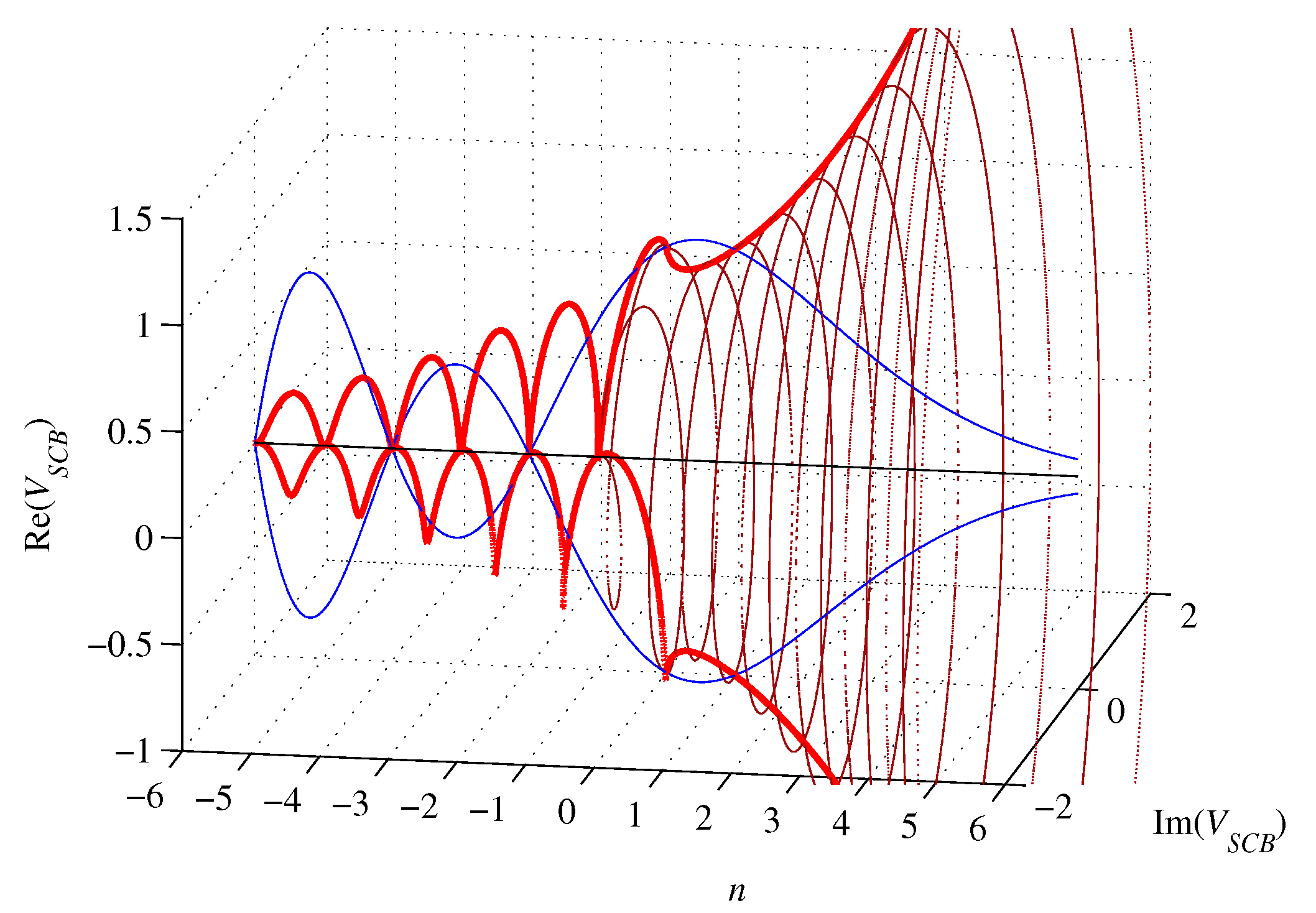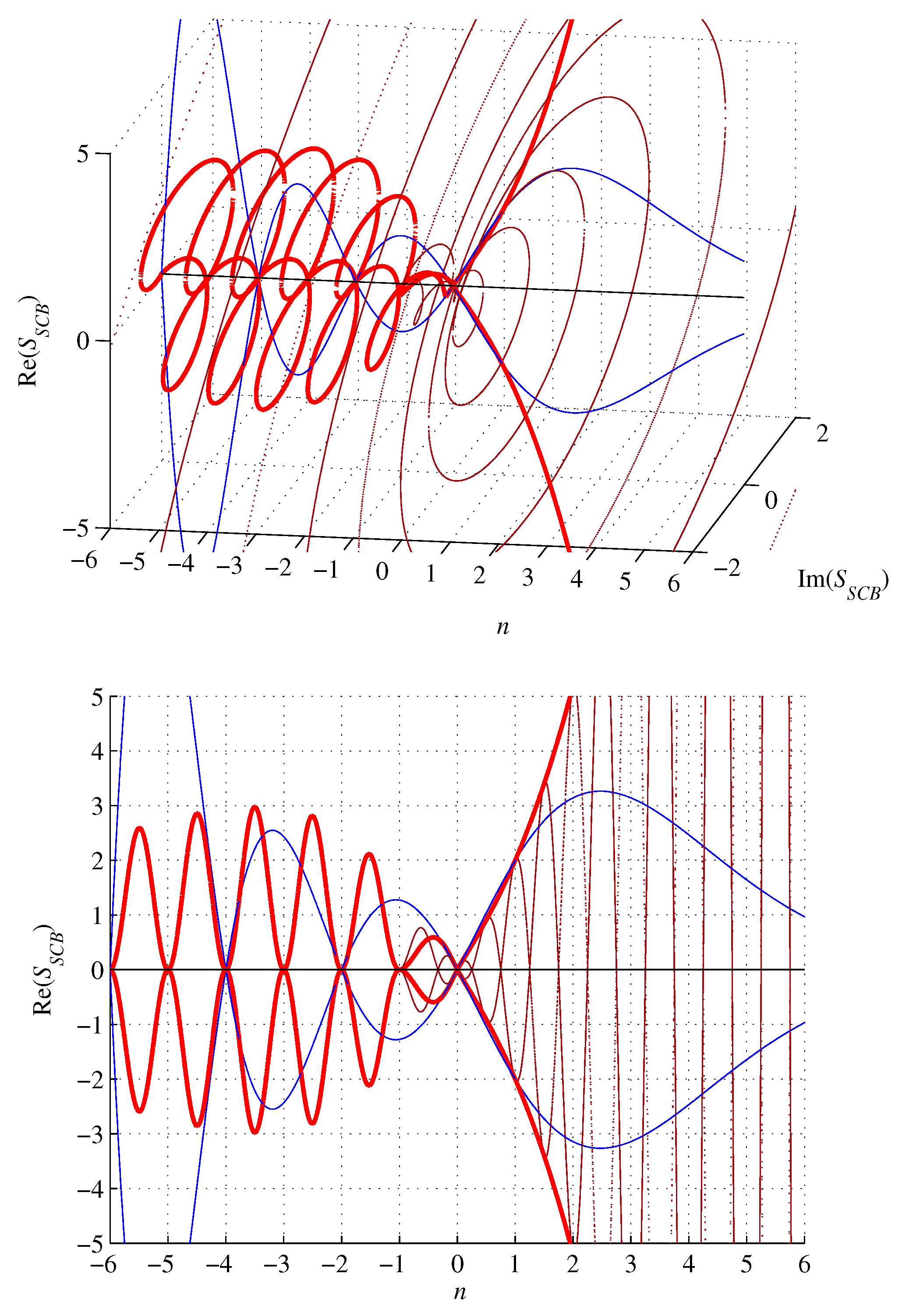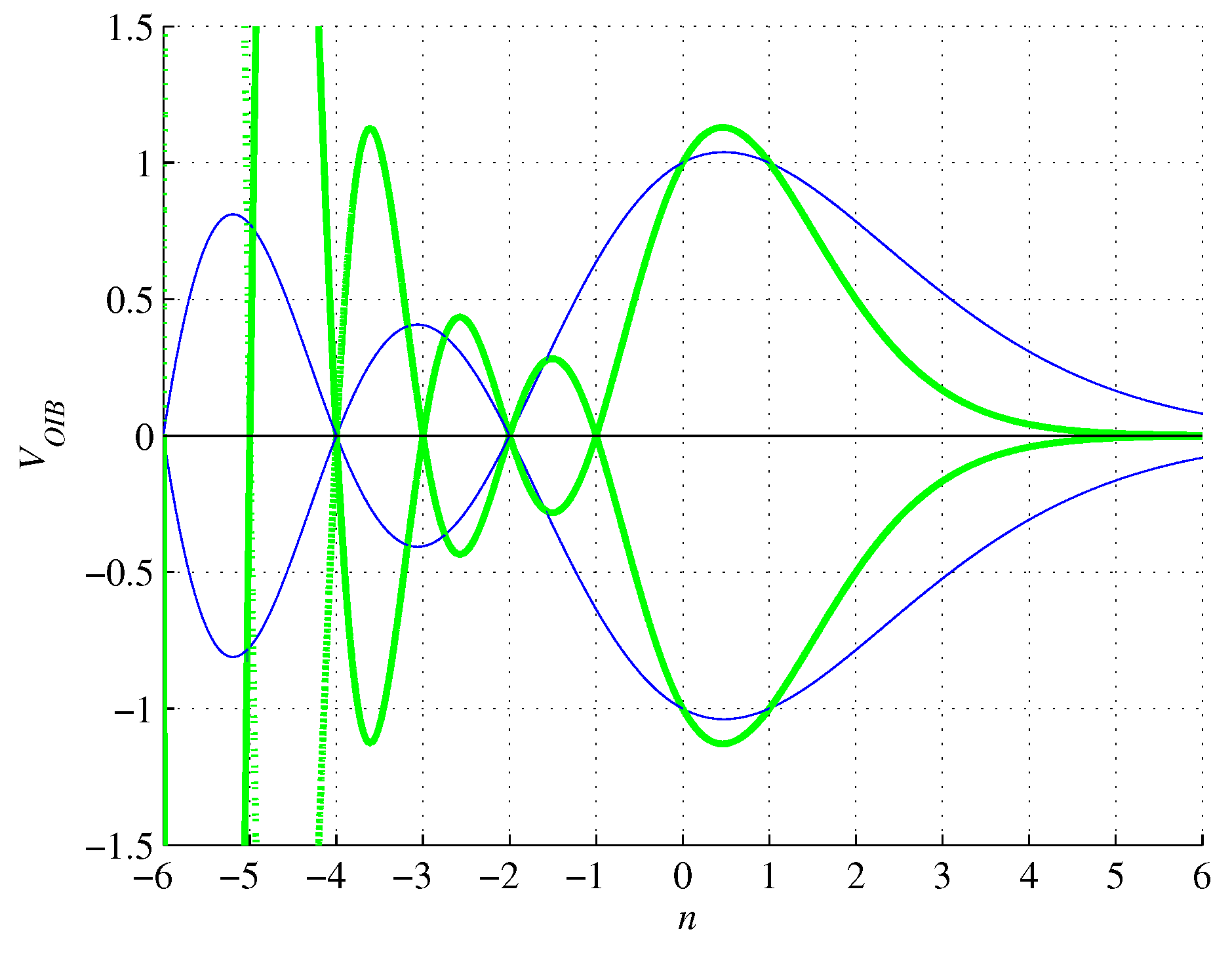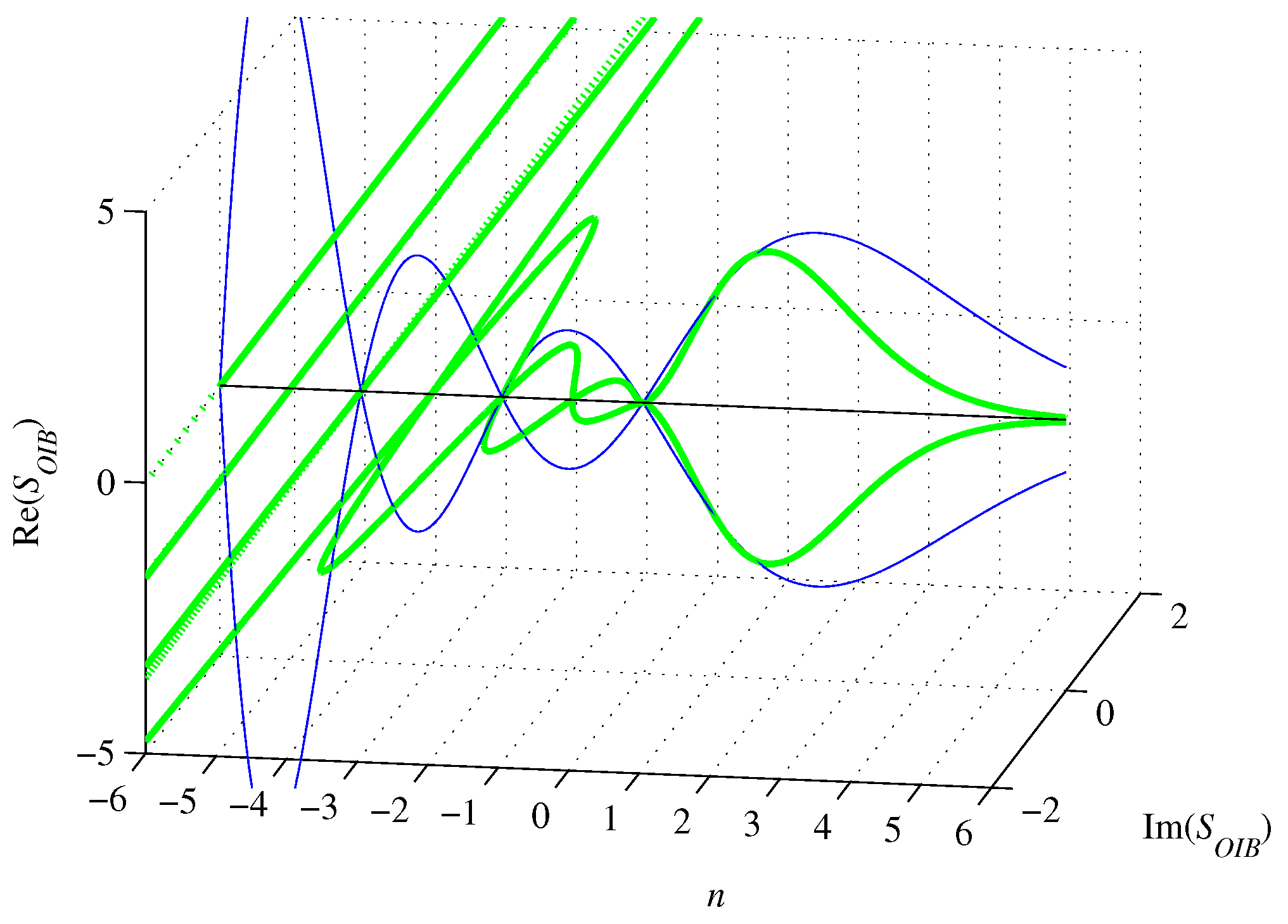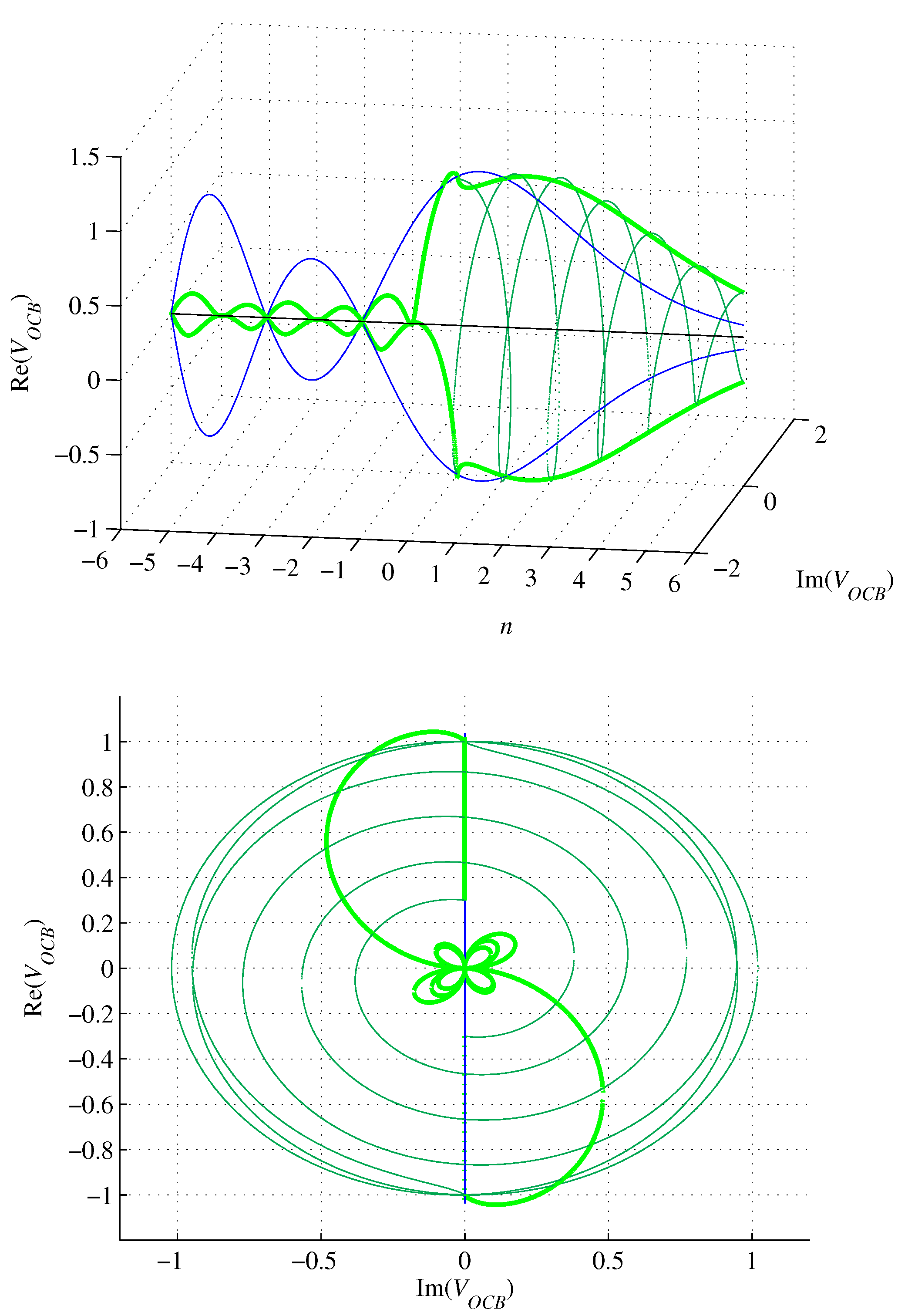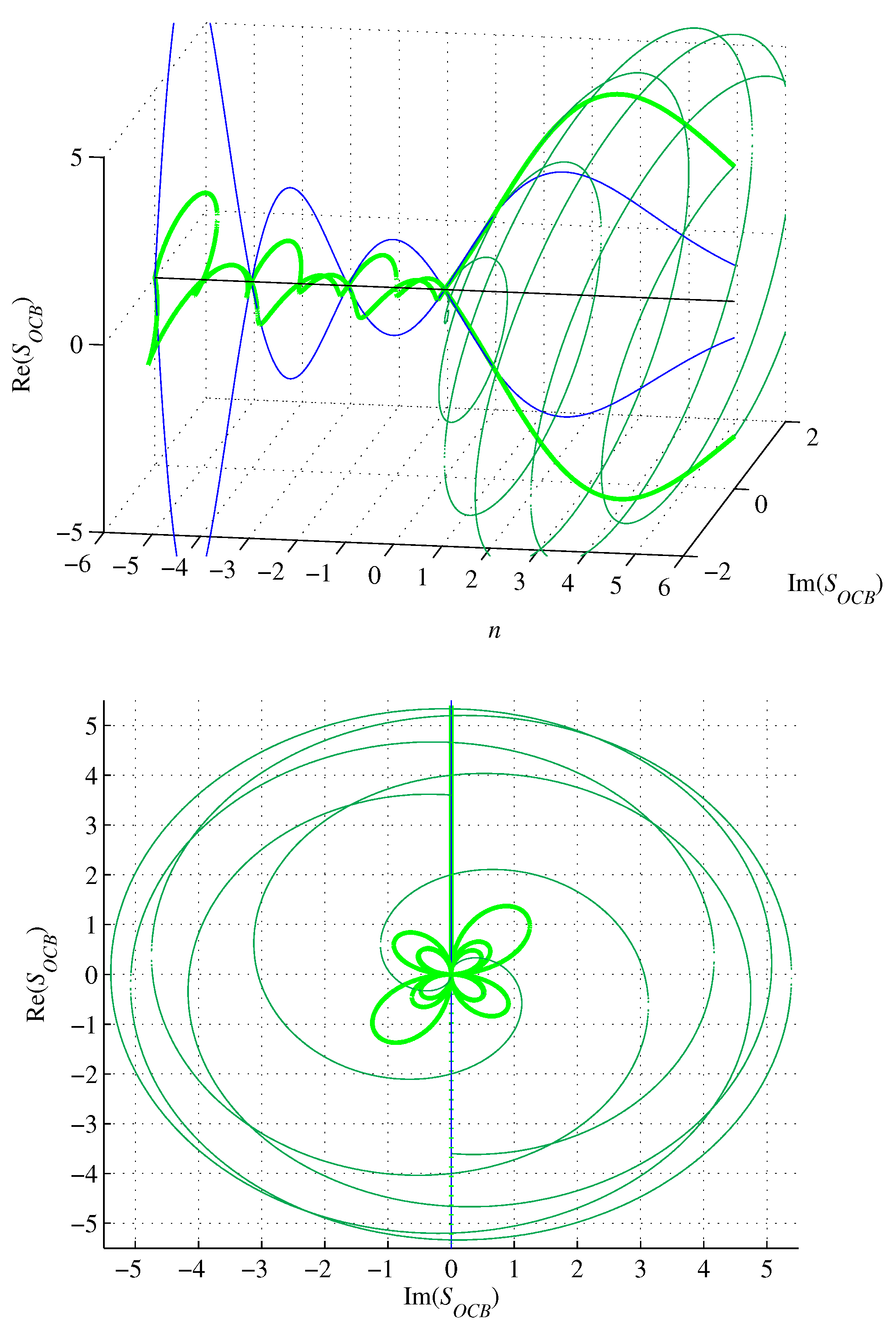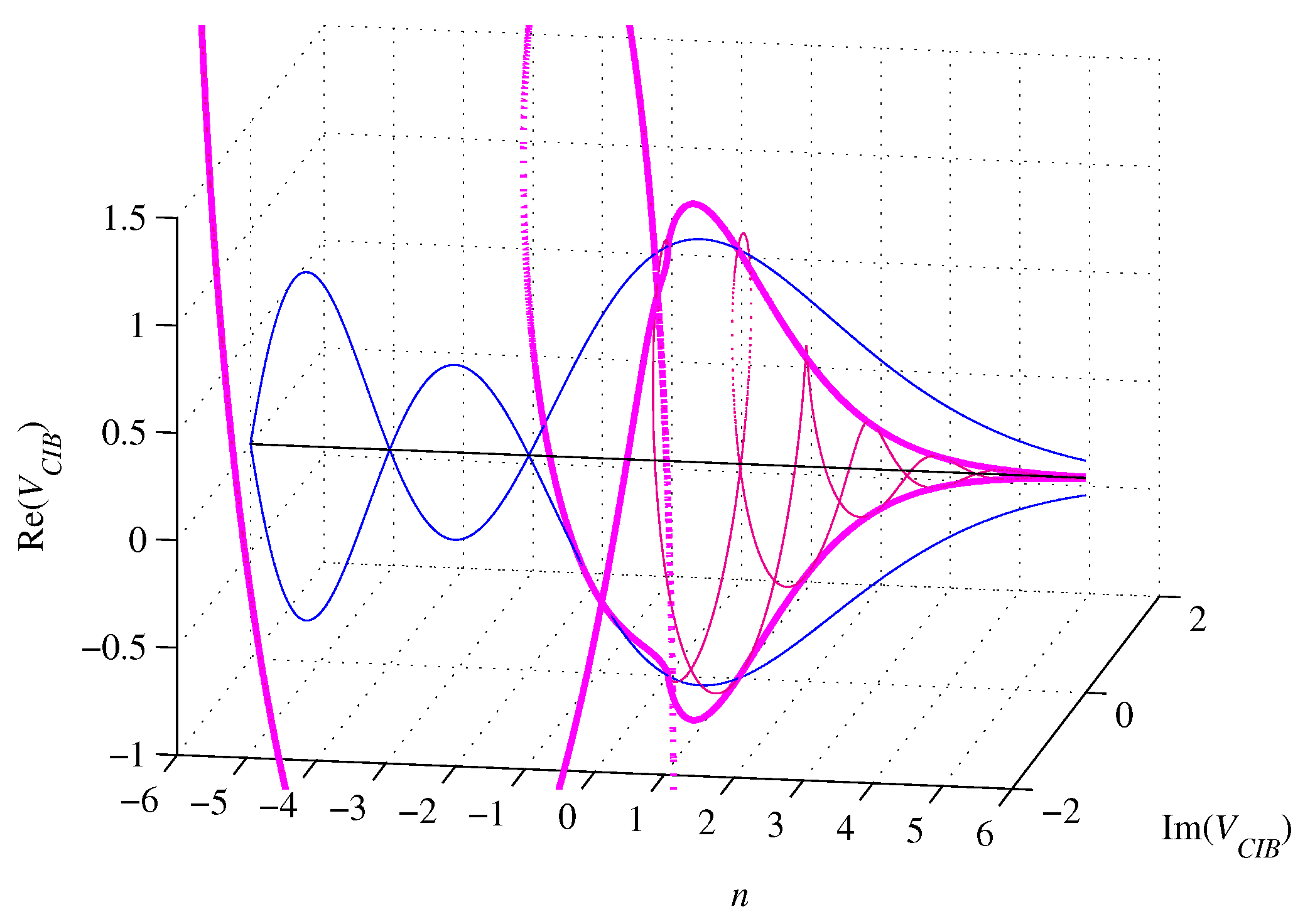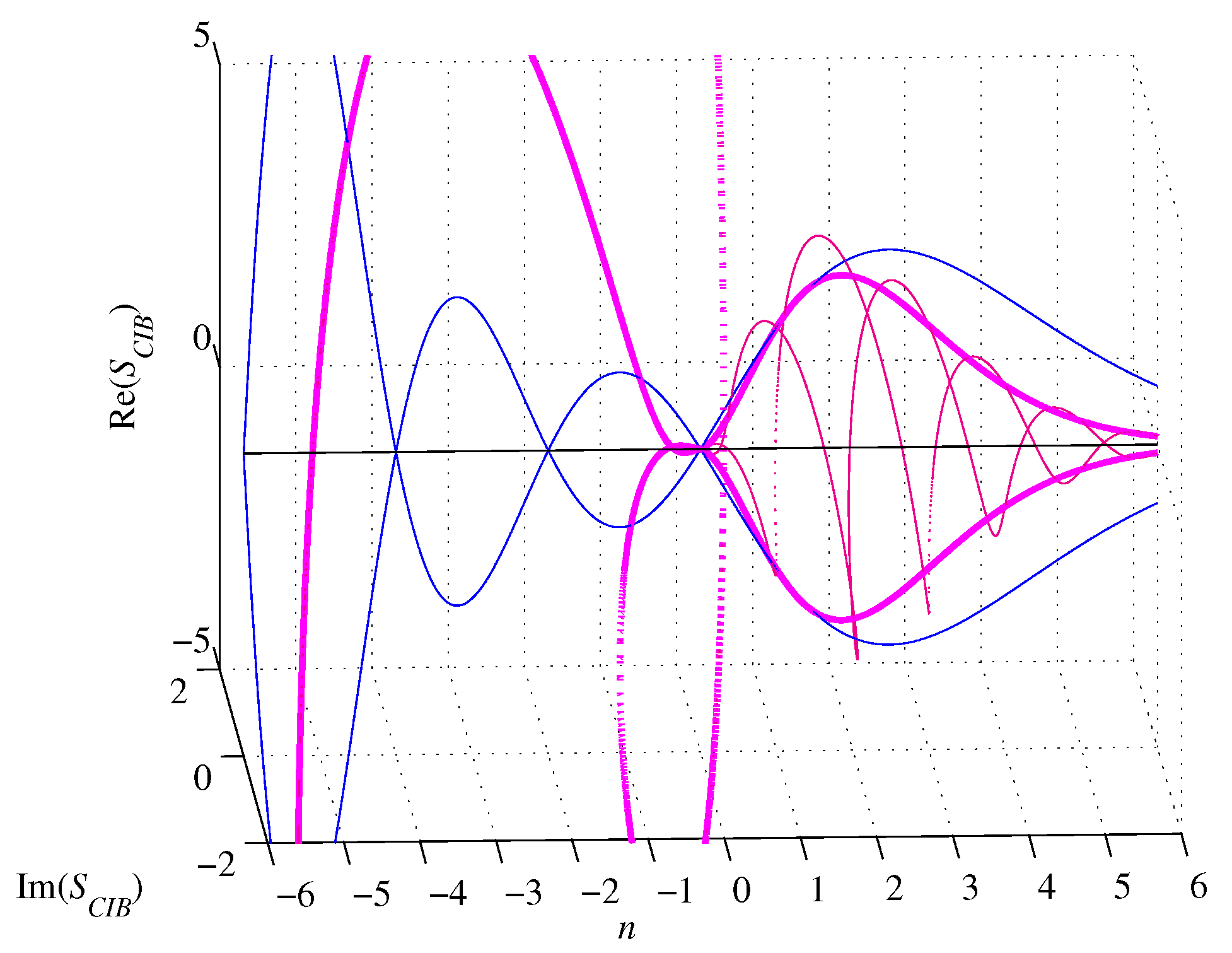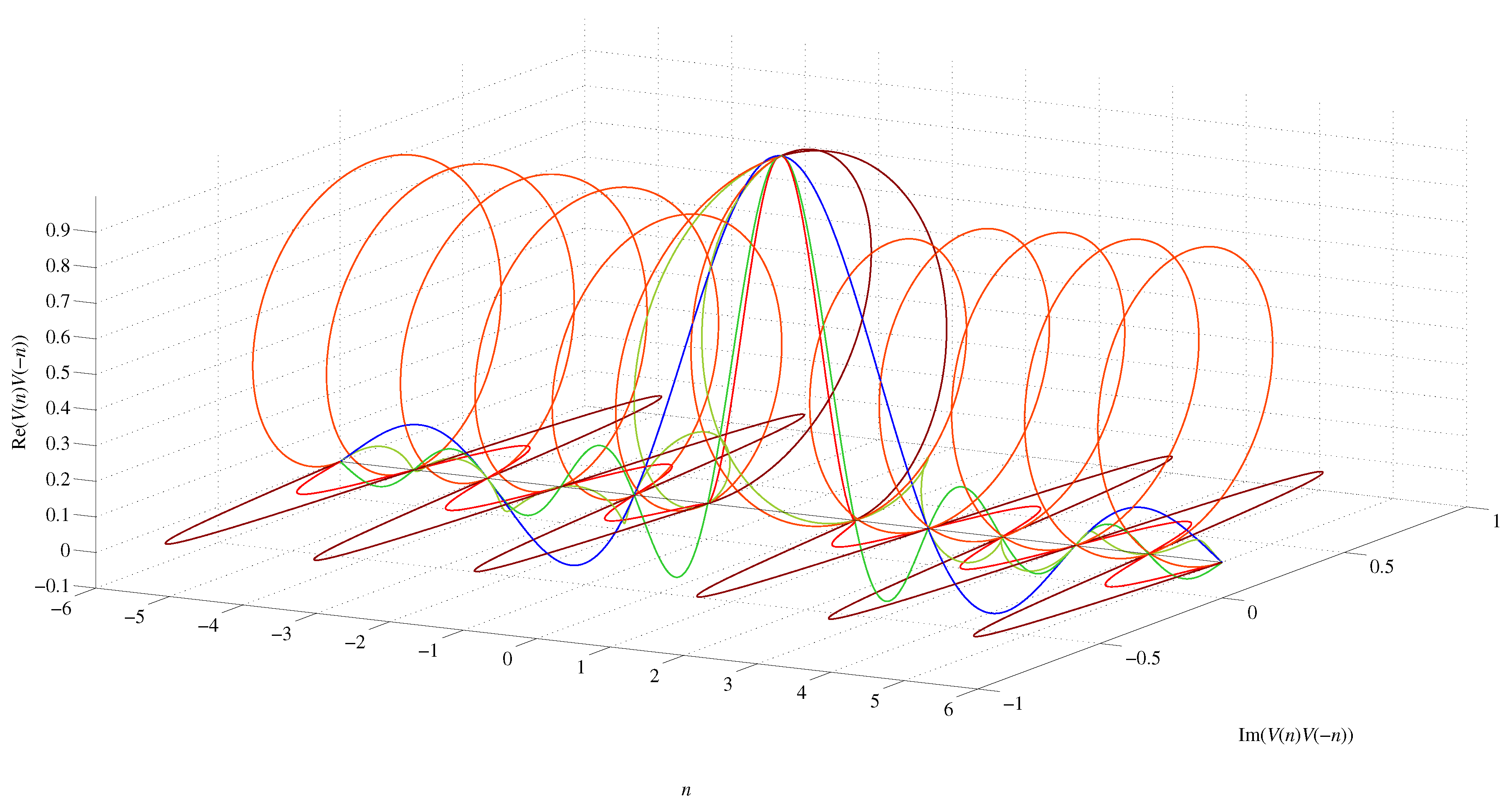I. INTRODUCTION
The notion of dimension
n is intuitively defined as a natural number of coordinates of a point within Euclidean space
. However, this is not the only possible definition [
1,
2] of a dimension of a set. For example, analytic continuations from positive dimensions [
2,
3,
4,
5] can define negative dimensions [
6]. Fractional (or fractal), including negative [
7], dimensions are consistent with experimental results and enable the examination of transport parameters in multiphase fractal media [
8,
9]. This renders dimension
n real, or at least a rational number. Complex [
2], including complex fractional [
10], dimensions can also be considered. Complex geodesic paths, for example, emerge in the presence of black hole singularities [
11] and when studying entropic dynamics on curved statistical manifolds [
12]. Complex wavelengths occur in Maxwell-Boltzmann, and Fermi-Dirac statistics on black hole event horizons [
13]. Fractional derivatives of complex functions can describe different physical phenomena [
14]. For example, it was recently shown [
15] that magnetic monopole motion in 3-simplicial spin ice crystal lattice is limited to a fractal cluster.
In
n-dimensional space,
n-dimensional objects have
-dimensional surfaces which have a dimension of volume in
-dimensional space. However, this sequence has a singularity at
. A 0-dimensional point in 0-dimensional space has a vanishing
-surface being a vanishing volume of the
-dimensional void. But the surface of the
-dimensional void is not
-dimensional. It is undefined. This discontinuity hints that thinking about dimension in terms of a point on a number axis, where negative dimensions are analytic continuations from positive ones, may be misleading. Thinking of the dimension as a point on a number semiaxis, similar to a point on a radius with
-dimension corresponding to
n-dimension, seems more appropriate. Considering the dimension of a set as the length exponent at which that set can be measured makes the negative dimensions refer to densities as positive ones refer to quantities [
5]. Thus, the
-dimensional pressure, for example, considered in terms of density (e.g., in units of N/m
2) corresponds to a 2-dimensional area (in units of m
2) that it acts upon. Following the same logic, gravitational force
acting towards an
inside of a 2-dimensional equipotential surface is
-dimensional, whereas centripetal force
acting towards an
outside of a 1-dimensional curve is
-dimensional.
The notion of distance intuitively defines how far apart two points are. Thus, intuition suggests that it is a non-negative quantity. However, intuition can be misleading
1, and the Euclidean distance admits not only the principal, non-negative, square root but also a negative one. This fact, taken plainly, violates the nonnegativity axiom of the metric. However, diffuse metrics [
16], including the Łukaszyk-Karmowski metric [
17], are known to violate the identity of indiscernibles axiom of the metric. This hints that axiomatizing distance as a non-negative quantity may also be misleading. Complex effects (bivalence) extend real effects (classically one value), just as quantum theory extends classical physics.
The study shows that the recurrence relations of the prior research [
18] allow removing indefiniteness present in known formulas for volumes and surfaces of the three polytopes present in all natural dimensions [
19], thus making them holomorphic functions of a complex dimension
n and omnidimensional (i.e., well defined
).
The paper is structured as follows.
Section II summarizes known formulas and recurrence relations for volumes and surfaces of
n-balls and regular, convex
n-polytopes.
Section III shows that these formulas and recurrence relations can be extended to all complex dimensions.
Section IV examines the properties of the omnidimensional, regular, convex polytopes inscribed in and circumscribed about
n-balls and their reflection functions.
Section V presents metric-independent relations between volumes and surfaces of these polytopes and
n-balls, whereas
Section VI presents particular symmetries between volumes and surfaces for
. Section sec:discussion concludes and discusses the findings of this study, hinting at their possible applications.
II. KNOWN FORMULAS
It is known that the volume of an
n-ball (
B) is
where
is the Euler’s gamma function,
,
[
18], and
R denotes the
n-ball radius. As the gamma function is meromorphic, volumes of
n-balls are complex in complex dimensions. The volume of an
n-ball can be expressed [
20] in terms of the volume of an
-ball of the same radius as a recurrence relation
where
and
. The relation (
2) can be extended [
18] into negative dimensions as
solving (
2) for
and assigning new
n as the previous
. A radius recurrence relation
2 [
18]
where
,
and
, allow for expressing the volume
n-ball as
where ”
” is the floor function that yields the greatest integer less than or equal to its argument
x. The relation (
4) can be, analogously as formula (
2), extended [
18] into complex dimensions with a negative real part as
which allows to define
to initiate the sequences (
4) or (
6). Known [
20] surface of an
n-ball
3 is
Known volume of
n-cube (
C) is
where
and
A is the edge length. The known surface of
n-cube is
where
.
Known [
21,
22] volume of a regular
n-simplex (
S) is
where
. The formula (
10) can be written [
18] as a recurrence relation
with
, to remove the indefiniteness of the factorial for
. Formula (
11) can be solved for
. Assigning new
n as the previous
, yields [
18]
which also removes the singularity for
present in the volume (
10).
n-simplex has
-facets [
20]. Therefore, its surface is
Known [
20] volume of an
n-orthoplex (
O) is
where
.
Formula (
14) can be written [
18] as a recurrence relation
where
and
, to remove the indefiniteness of the factorial for
. Solving (
15) for
and assigning new
n as the previous
, yields [
18]
which also removes singularity for
present in formula (
15). Any
n-orthoplex has
facets [
20], which are regular
-simplices. Therefore, its surface is
III. HOLOMORPHIZING KNOWN FORMULAS
Known formulas presented in the preceding section can be extended to all complex dimensions. We note that volumes and surfaces of
n-cubes are already defined
and thus holomorphic. We also note that a square root is bivalued in the complex domain
4. Therefore, volumes and surfaces of
n-balls and regular, convex
n-polytopes are also bivalued in complex dimensions
n. We call
principal branch the branch with positive values in positive real dimensions.
Theorem 1 The volume of an n-ball is a holomorphic, bivalued function of a complex dimension n.
Proof. First, we note that the initial bivalued values for the radius recurrence relations (
4), (
6) are
,
and
. Then, we note that the recurrence relations (
3) and (
5) correspond to each other
which, after setting
, yields
Comparing the non-recurrence general
n-ball volume formula (
1), which is bivalued for
and valid within the domain of the gamma function, with the recurrence relation (
3)
yields
Setting
yields
which recovers (
1), as
,
,
. Thus we have proved that the recurrence relations (
2), (
3), and (
5) correspond to the general
n-ball volume formula (
22) within this domain.
However, now we can use any of the
backward recurrence relations (
3) or (
5) with (
6) to determine the values of the
n-ball volume outside this domain:
we can find
.
On the other hand
so the poles of the meromorphic gamma function
present in (
22), now defined in the sense of a limit of a function, vanish, which completes the proof. □
Corollary 1.1. The surface of an n-ball is a holomorphic, bivalued function of a complex dimension n.
Proof. If the volume of an
n-ball is a holomorphic, bivalued function by Theorem 1, then, using formula (
7), the surface of an
n-ball is also a holomorphic function.
Using (
22) and (
7) the surface of an
n-ball is given by
□
Theorem 2 The volume of a regular n-simplex is a holomorphic, bivalued function of a complex dimension n.
Proof. Expressing the factorial in the volume of a regular
n-simplex formula (
10) by the gamma function extends the domain of applicability of (
10) to complex dimensions
On the other hand, comparing the volume (
25) with the recurrence relation (
12)
yields
which, after setting
, yields
and recovers (
25) as
and
(cf.
Appendix A). Thus, we have proved that the recurrence relation (
12) corresponds to the generalized
n-simplex volume formula (
25) within this domain.
However, now we can use the recurrence relation (
12) to determine the values of the
n-simplex volume outside this domain:
we can find
. For example, even though
is undefined for
, we can determine that
using the recurrence relation (
12) with
obtained from (
25).
On the other hand
so the poles of the meromorphic gamma function
present in (
25), now defined in the sense of a limit of a function, vanish - which completes the proof. □
For
},
n-simplex volume formula (
25) is imaginary.
Corollary 2.1. The surface of a regular n-simplex is a holomorphic, bivalued function of a complex dimension n.
Proof. If the volume of a regular
n-simplex is a holomorphic, bivalued function by Theorem 2, then its surface, using formula (
13), is also a holomorphic, bivalued function.
Using (
13) and (
25) the surface of a regular
n-simplex is given by (cf.
Appendix A)
□
Again, even though
is undefined for
, we can determine that
directly from formula (
13) knowing that
.
For
,
n-simplex surface formula (
30) is imaginary.
Theorem 3. The volume of an n-orthoplex is a bivalued, holomorphic function of a complex dimension n.
Proof. Expressing the factorial in the volume of an
n-orthoplex formula (
14) by the gamma function extends the domain of applicability of (
14) to complex dimensions
On the other hand, comparing (
31) with the recurrence relation (
16)
yields
whereas setting
in (
33) yields
which recovers
n-orthoplex volume (
14), as
. Thus, we have proved that the recurrence relation (
16) corresponds to the general
n-orthoplex volume formula (
31) within this domain.
However, now we can use the recurrence relation (
16) to determine the values of the
n-orthoplex volume outside this domain:
we can find
. On the other hand
so the poles of the meromorphic gamma function
present in (
31), now defined in the sense of a limit of a function, vanish - which completes the proof. □
Corollary 3.1. The surface of an n-orthoplex is a holomorphic, bivalued function of a complex dimension n.
Proof. If the volume of a regular
n-simplex is a holomorphic, bivalued function by Theorem 2, then, using formula (
17), the surface of an
n-orthoplex is a holomorphic, bivalued function.
Using (
17) and (
31) the surface of an
n-orthoplex is given by
□
For
,
n-orthoplex bivalued surface formula (
36) is imaginary.
Thus, the volumes and surfaces of
n-balls,
n-simplices, and
n-orthoplices, shown in Figs
1 and
2 for
, are holomorphic functions of
n, which makes those objects omnidimensional. They can be explicitly expressed in terms of the complex dimension (cf.
Appendix B).
A. Regular n-Simplices Inscribed in n-Balls
The diameter
of an
n-ball circumscribing a regular
n-simplex (
) is known [
22] to be
where
A is the edge length. Hence, the edge length
of a regular
n-simplex inscribed (
) in an
n-ball (
B) with diameter
D is
so that the regular
n-simplex volume (
25) becomes
For
the inscribed n-simplex volume (
49) is imaginary and divergent with
n approaching negative infinity. It is complex for
, with the real part equaling the imaginary part for
. It is zero for
, and for
, it is larger than the volume of the circumscribing
n-ball. The volume (
49) does not have a reflection function (
38), as
d in (
39) vanishes.
Similarly, the surface (
30) of a regular inscribed
n-simplex with edge length
A given by (
48) is
as shown in
Fig. 4. For
the inscribed
n-simplex surface (
50) is imaginary and divergent with n approaching negative infinity. It is complex for
, with the real part equaling the imaginary part for
. It is zero for
,
. The surface (
50) does not have a reflection function (
38), as
d in (
39) vanishes.
Volume (
49) and surface (
50) of
n-simplices inscribed in
n-balls are shown in Figs.
3 and
4.
B. Regular n-Simplices Circumscribed About n-Balls
The diameter
of an
n-ball inscribed in a regular
n-simplex (
) is known [
22] to be
where
A is the edge length. Hence, the edge length
of a regular
n-simplex circumscribed (
) about an
n-ball (
B) with diameter
D is
so that its volume (
25) becomes
For
, the volume (
53) is complex with a nonzero imaginary part, whereas both branches are left-handed spirals converging to zero with
n approaching negative infinity. For
, the volume (
53) is smaller than the volume of the inscribed
n-ball. It is zero for
, and real for
, where it amounts
Furthermore, for
and
, the real part of the volume (
53) equals the imaginary part up to a modulus. For
,
. Otherwise, it amounts
The reflection function (
38) of the volume (
53) is
and the volumes (
56) and (
53) are equal for
.
Similarly, the surface (
30) of a regular circumscribed
n-simplex with edge length
(
52) is
The surface (
57) is zero for
,
, and for
, it is smaller than the surface of the inscribed
n-ball. The surface (
57) is complex for
, with both branches being left-handed spirals converging towards zero with
n approaching negative infinity. However, it is initially divergent to achieve a modulus maximum of about 2.9757 at
(numerically calculated) and a real maximum of about
at
. For
the imaginary part of the surface (
57) vanishes and it amounts
The real part of the surface (
57) is equal to the imaginary part up to a modulus for
(
) and
The reflection function (
38) of the surface (
57) is
and it equals (
53) for
.
Volumes (
53) and surfaces (
57) of
n-simplices circumscribed about
n-balls are shown in Figs.
5 and
6.
D. n-Orthoplices Circumscribed About n-Balls
The diameter
of an
n-ball inscribed in an
n-orthoplex (
) is known [
23] to be
where
A is the edge length. Hence, the edge length
of an
n-orthoplex circumscribed about an
n-ball (
) with diameter
D is
so that its volume (
31) becomes
as shown in
Fig. 9.
Circumscribed
n-orthoplex volume (
67) is complex for
. It oscillates and is initially convergent to achieve a modulus minimum of about 0.1181 at
(numerically computed) and then becomes divergent with
n approaching negative infinity. For
, it vanishes. For
, it is smaller than the volume of the inscribed
n-ball. For
,
the real part of the volume (
67) equals the imaginary part up to a modulus, achieving a local minimum at
and amounts
The reflection function (
38) of the volume (
67) is
and it equals the volume (
67) for
,
.
Similarly, the surface (
36) of the circumscribed
n-orthoplex with edge length
A given by (
66) becomes
as shown in
Fig. 10.
Circumscribed
n-orthoplex surface (
70) is complex for
. It oscillates and is initially convergent to achieve a modulus minimum of about 0.6244 at
(numerical) and then becomes divergent with
n approaching negative infinity. For
, it vanishes. For
, it is smaller than the surface of the inscribed
n-ball. Furthermore, its real part equals the imaginary part up to a modulus for
,
. It achieves a local minimum at
and amounts
The reflection function (
38) of the surface (
70) is
and it equals (
70) for
,
.
Volumes (
67), (
69) and surfaces (
70), (
72) of
n-orthoplices inscribed in
n-balls are shown in Figs.
9 and
10.
V. METRIC-INDEPENDENT RELATIONS
The following metric-independent relations hold, for
, between volumes of
n-balls (
22)
n-simplices (
25)
n-orthoplices (
31) and
n-orthoplices inscribed in
n-balls (
63)
n-simplices inscribed in
n-balls (
49)
n-simplices circumscribed about
n-balls (
53)
and
n-orthoplices circumscribed about
n-balls (
67)
where we used Euler’s reflection formula,
, with
, and
as well as (for
), between surfaces of
n-balls (
24)
n-simplices (
30),
n-orthoplices (
36)
n-simplices inscribed in
n-balls (
50)
n-simplices circumscribed about
n-balls (
57)
n-orthoplices inscribed in
n-balls (
64)
n-orthoplices circumscribed about
n-balls (
70)
and
n-cubes inscribed in
n-balls (
77) (
)
where we again used
and Euler’s reflection formula
These relations are independent of the distance value
D and its particular form, whether negative (
) or complex (
,
), including purely imaginary (
). Furthermore, the relations (
80)-(
85) and (
87)-(
93) are independent of the gamma function. Relations (
80)-(
85) are shown in
Fig. 13. The imaginary part of the surface relations (
88)-(
94) vanishes for
.
Also, for
, the following both metric and gamma function independent relations can be obtained between volumes (
73), (
76) and surfaces (
74), (
77) of circumscribed and inscribed
n-cubes
between volumes (
53), (
49) and surfaces (
57), (
50) of circumscribed and inscribed
n-simplices
and between volumes (
67), (
63) and surfaces (
70), (
64) of circumscribed and inscribed
n-orthoplices
Notably, the ratio of the volume of
n-cube circumscribed about
n-ball
to the volume of
n-cube inscribed in
n-ball
(
96) is the same as the ratio of the volume of
n-orthoplex circumscribed about
n-ball
to the volume of
n-orthoplex inscribed in
n-ball
(
98), and the same holds for the ratio of their surfaces,
. This is unsurprising: as
n-cube is dual to
n-orthoplex, these ratios remain invariant.
VII. DISCUSSION
The volumes and surfaces of
n-balls,
n-simplices, and
n-orthoplices have been defined in any complex dimension. As these geometric objects occur, along with
n-cubes, in all natural dimensions [
19], this result makes them omnidimensional, that is, present in any complex dimension.
Applications of these formulas to the omnidimensional polytopes inscribed in and circumscribed about n-balls revealed previously unknown properties of these geometric objects. In particular, for , the omnidimensional polytopes’ volumes are larger than those of circumscribing n-balls, while their volumes and surfaces are smaller than those of inscribed n-balls.
Reflection functions for volumes and surfaces of these polytopes inscribed in and circumscribed about n-balls are proposed.
Symmetries of products (
80)-(
85), (
87)-(
94) and quotients (
96)-(
98) of volumes of these circumscribed and inscribed omnidimensional polytopes and
n-balls in complex dimensions
n and
and of surfaces in complex dimensions
n and
are shown to be independent of the metric factor and the gamma function.
Specific symmetries also hold between volumes and surfaces in dimensions and .
The results of this study could be applied in linguistic statistics, where the dimension in the distribution for frequency dictionaries is chosen to be negative [
3], in fog computing, where
n-simplex is related to a full mesh pattern,
n-orthoplex is linked to a quasi-full mesh structure, and
n-cube is referred to as a certain type of partial mesh layout [
24]. Further possible applications include molecular physics and crystallography. Perhaps the results of this study are also related to the 2-dimensional quantum hall effect.
One can also investigate the properties of the examined geometric objects extending these concepts to quaternions. This can help us discover many interesting mathematical properties and physical phenomena. One of the challenges certainly involves characterizing all types of symmetries introduced by Definition 1.
Figure 1.
Graphs of volumes (V) and surfaces (S) of unit edge length regular n-simplices (red), n-orthoplices (green), n-cubes (pink), and unit diameter n-balls (blue), along with the integer recurrence relations (dashed lines) for .
Figure 1.
Graphs of volumes (V) and surfaces (S) of unit edge length regular n-simplices (red), n-orthoplices (green), n-cubes (pink), and unit diameter n-balls (blue), along with the integer recurrence relations (dashed lines) for .
Figure 2.
Graphs of volumes (V) and surfaces (S) of unit edge length regular n-simplices (red), n-orthoplices (green), and unit diameter n-balls (blue) for .
Figure 2.
Graphs of volumes (V) and surfaces (S) of unit edge length regular n-simplices (red), n-orthoplices (green), and unit diameter n-balls (blue) for .
Figure 3.
Graphs of (red) and (blue) for .
Figure 3.
Graphs of (red) and (blue) for .
Figure 4.
Graphs of (red) and (blue) for .
Figure 4.
Graphs of (red) and (blue) for .
Figure 5.
Graphs of (red), (blue), and (dark red), for .
Figure 5.
Graphs of (red), (blue), and (dark red), for .
Figure 6.
Graphs of (red), (blue), and (dark red), for .
Figure 6.
Graphs of (red), (blue), and (dark red), for .
Figure 7.
Graphs of (green) and (blue), for .
Figure 7.
Graphs of (green) and (blue), for .
Figure 8.
Graphs of (green) and (blue), for .
Figure 8.
Graphs of (green) and (blue), for .
Figure 9.
Graphs of (green), (blue), and (dark green), for .
Figure 9.
Graphs of (green), (blue), and (dark green), for .
Figure 10.
Graphs of (green), (blue), and (dark green), for .
Figure 10.
Graphs of (green), (blue), and (dark green), for .
Figure 11.
Graphs of (pink), (blue), and (dark pink), for .
Figure 11.
Graphs of (pink), (blue), and (dark pink), for .
Figure 12.
Graphs of (pink), (blue), and (dark pink), for .
Figure 12.
Graphs of (pink), (blue), and (dark pink), for .
Figure 13.
Volume metric and gamma function independent relations. (blue), (red), (dark red), (orange red), (lime green), (yellow green), for .
Figure 13.
Volume metric and gamma function independent relations. (blue), (red), (dark red), (orange red), (lime green), (yellow green), for .
Table I.
Particular volumes of omnidimensional polytopes inscribed in and circumscribed about unit diameter n-balls (principal branch).
Table I.
Particular volumes of omnidimensional polytopes inscribed in and circumscribed about unit diameter n-balls (principal branch).
| n |
|
−1 |
|
0 |
|
1 |
|
|
0.331 |
|
|
1 |
|
1 |
|
|
|
0 |
|
1 |
|
1 |
|
|
|
0 |
|
1 |
|
1 |
|
|
|
0 |
|
1 |
|
1 |
|
|
|
0 |
|
1 |
|
1 |
|
|
|
i |
|
1 |
|
1 |
|
|
1 |
1 |
1 |
1 |
1 |
1 |
1 |
Table II.
Particular surfaces of omnidimensional polytopes inscribed in and circumscribed about unit diameter n-balls (principal branch).
Table II.
Particular surfaces of omnidimensional polytopes inscribed in and circumscribed about unit diameter n-balls (principal branch).
| n |
|
−1 |
|
0 |
|
1 |
|
|
|
|
|
0 |
|
2 |
|
|
|
0 |
|
0 |
|
2 |
|
|
|
0 |
|
0 |
|
2 |
|
|
|
0 |
|
0 |
|
2 |
|
|
|
0 |
|
0 |
|
2 |
|
|
|
2 |
|
0 |
|
2 |
|
|
|
|
|
0 |
1 |
2 |
3 |
